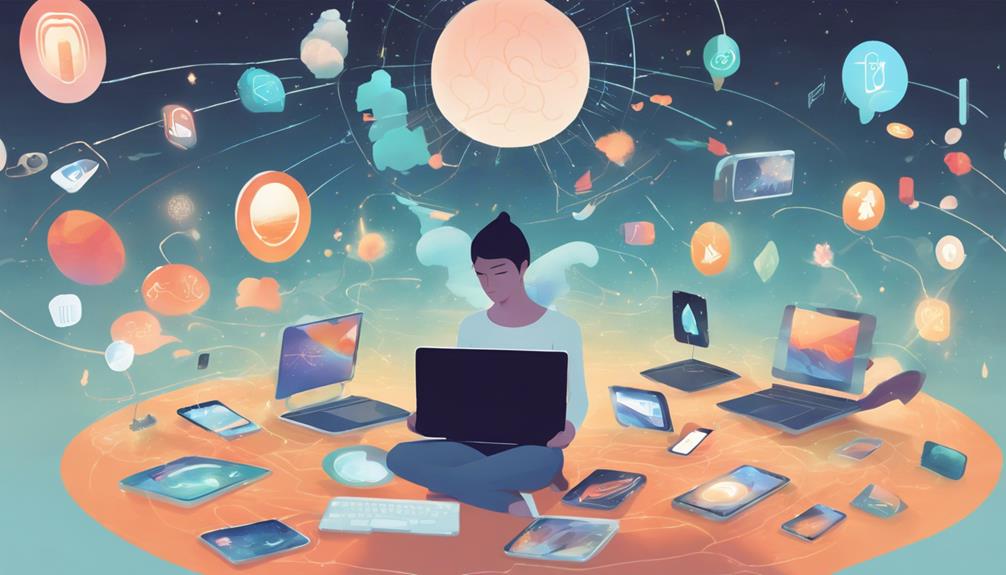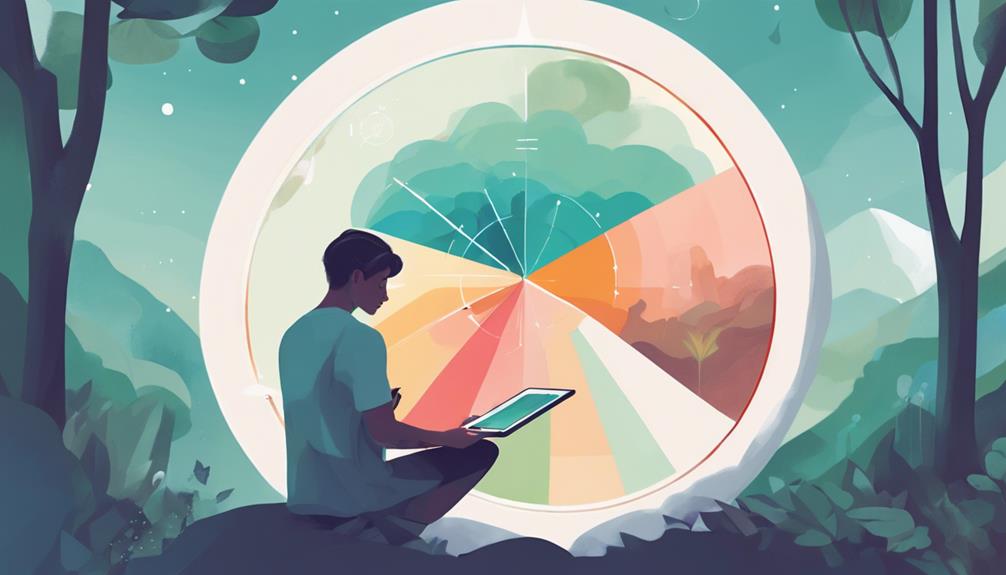Summary
- 1 Understanding digital overload
- 2 Benefits of a Digital Detox
- 3 Evaluation of your time in front of the screen
- 4 Setting clear goals
- 5 Creation of Technology-Free Zones
- 6 Establishing moments without a screen
- 7 Looking for offline activities
- 8 Mindfulness and Meditation
- 9 Reconnecting with nature
- 10 Managing job expectations
- 11 Involving Family and Friends
- 12 Maintaining balance in the long term
- 13 Frequently asked questions
Feeling overwhelmed by constant notifications? A digital pause can help you regain your focus and well-being. Start by assessing your time spent in front of the screen using your device's tracking features. Set goals to limit screen use, such as avoiding devices during meals or before bedtime. Create technology-free zones in your home, such as the bedroom or dining area. Involve family and friends for mutual support and promote device-free activities together. Remember to take breaks and reconnect with nature to enliven your mind. Respect clear boundaries for long-term balance and improve your mental clarity and productivity. Learn more tips and steps to enrich your detoxification journey.
Understanding digital overload

When you are constantly bombarded with notifications, emails and social media updates, it is easy to feel overwhelmed and distracted. This state of continuous digital interaction is what is known as digital overload. It affects you without you knowing it, affecting your concentration and productivity.
Understanding digital overload starts with recognizing its signals. Do you find it difficult to focus on a single task without checking your phone? Are you experiencing increased stress, fatigue, or anxiety? These are alarm bells that indicate your digital consumption may be too high.
Digital overload does not only affect your mental state; it can also affect your physical well-being. Spending too much time in front of screens can cause eye strain, headaches and poor posture. In addition, the constant flow of information can make it difficult for your brain to process and store important details.
To combat digital overload, start by setting limits. Set specific times to check email or social media and stick to them. Turn off non-essential notifications to reduce distractions. With these small steps, you can begin to regain control over your digital life and improve your overall well-being.
Benefits of a Digital Detox
Taking a break from screens can greatly improve your mental clarity And your general well-being. When you drive away from constant notifications and endless scrolling, your mind has a chance to rest and reset. You will find it easier to focus on tasks, which can increase your productivity. In addition, spending less time in front of the screen often means being less exposed to stressful news and drama on social media.
Another major benefit is a improved sleep. Blue light from screens can interfere with your sleep cycle, making it difficult to fall asleep or stay asleep. By reducing the time you spend in front of the screen, especially before bedtime, you are more likely to enjoy a restful, uninterrupted sleep.
Even your physical health can improve. Spending less time bent over devices can reduce neck and back pain. You will also have more time for physical activities such as walking, stretching, or simply getting outdoors to get some fresh air.
Finally, a digital detox can improve your personal relationships. When you are not glued to a screen, you can be more present with family and friends. This leads to deeper and more meaningful connections, which can significantly increase your happiness and emotional well-being. So, try and observe the positive changes manifest.
Evaluation of your time in front of the screen

Understanding your current time spent in front of the screen is the first step toward successful digital detoxification. You cannot improve what you do not measure, right? Start by checking the time spent in front of the screen tracker built into your smartphone or tablet. Most devices have this function in the menu settings. It will show you how much time you are spending on different apps and activities.
Once you have your data on time spent in front of the screen, take a closer look. Are you surprised by the results? Perhaps you didn't realize how much time you spend scrolling on the social media or to watch TV series. Write down these numbers and point out which apps or activities take up most of your time.
Next, reflect on how this time spent in front of the screen makes you feel. Do some apps leave you feeling exhausted or anxious? Identifying these emotional responses can help you understand what digital habits you might want to change.
Setting clear goals
Now that you have assessed the time spent in front of the screen, it is essential to set clear objectives For your digital detox. Start by identifying what you want to achieve. Do you want to Reduce the time spent at the computer Of a specific number of hours? Or do you perhaps aim to spend more quality time With family and friends? Being specific will help you stay on track.
Next, divide these goals into. manageable steps. If you want to reduce time spent on the computer by two hours a day, think about when and where you can make these reductions. Perhaps you can start by reducing use during meals or before bedtime. Writing down these small, concrete steps can make the process less overwhelming.
Consider setting goals at both short-term that at long-term. Short-term goals might include, for example, not checking your phone during meals for a week. Long-term goals might be something broader, such as maintaining a balance in your digital life for several months.
Don't forget to monitor your progress. Use a journal or simple checklist to see how you are progressing. Celebrate small successes to keep yourself motivated. Remember, setting clear goals is not just about reducing time spent at the screen; it's about Regain control of your concentration and well-being.
Creation of Technology-Free Zones

Once you've set your goals, it's time to establish technology-free zones in your home to help you stay on track. Start by choosing spaces where you spend a lot of time, such as your bedroom, dining area or living room. These should be places where you can relax, connect with others and focus on activities without the constant temptation of screens.
Turn your bedroom into a sanctuary for rest while keeping it free of technology. Charge your phone in another room and use a traditional alarm clock. This helps you fall asleep better at night and wake up more rested.
In the dining area, make meals a time to connect with family or friends. Make a rule that all devices stay off on the table. You will be amazed at how much more meaningful and enjoyable your conversations will become.
For the living room, designate specific times when it is a screen-free zone. Use this time to read, play board games, or simply chat. Redescover how satisfying these interactions can be.
Establishing moments without a screen
Setting specific times to disconnect from devices can greatly improve your concentration and well-being. It is crucial to find times during the day when you get completely away from screens. Start slow by establishing screen-free periods during meals or an hour before bedtime. You will be amazed at how these short breaks can revitalize your mind.
Here is a simple table to help you set up screen-free moments:
| Activities | Timetable without screen | Benefit |
|---|---|---|
| Morning routine | 7:00 – 8:00 | Start the day with awareness |
| Meal times | 12:00 – 13:00 | Enjoy the food and the company |
| Afternoon break | 15:00 – 15:30 | Improves concentration in the afternoon |
| Relaxing evening | 19:00 – 20:00 | Relax and destress |
| Pre-dream rituals | 21:00 – 22:00 | Improves the quality of sleep |
Looking for offline activities

Now that you have devoted some screen-free time, let's find out some fun offline activities. Try outdoor hobbies like hiking or gardening to connect with nature. Or, devote yourself to creative activities as painting or writing to keep the mind engaged.
Exploring Outdoor Hobbies
Unplug and rediscover the joy of nature by trying outdoor hobbies such as hiking, gardening o birdwatching. These activities can help you reconnect with the world around you and offer a revitalizing break from screens.
Hiking is a great way to get around and discover new places. Find a nearby path Or a nature reserve, lace up your boots And start walking. Pay attention to the sights, sounds and smells of nature. You may be surprised at how much is soothing.
Gardening is another quiet outdoor hobby. Even if you don't have a large garden, you can start with a few pots or a small flower bed. Planting flowers, vegetables or herbs can be incredibly rewarding and rooting. In addition, you will enjoy the results of your work!
Birdwatching allows you to slow down and observe the beauty of wildlife. Grab a pair of binoculars and a bird guide, and head to a local park or natural area. See how many different species you can spot. It's a simple but rewarding way to spend time outdoors.
Involvement in creative activities
After enjoying time outdoors, why not channel your creativity with offline activities that inspire and engage your mind? Engaging in creative activities can help you disconnect from screens and reconnect with your inner self. It's about finding activities that make you lose your perception of time and feel genuinely fulfilled. Here are some ideas to get you started:
| Activities | Benefits |
|---|---|
| Painting | Increases creativity and reduces stress |
| Playing an instrument | Improves coordination and enhances mood |
| Writing | Amplifies clarity of thought and expression |
| Manual labor | Promotes problem solving and patience |
| Kitchen/Bakery | Promotes awareness and creativity |
Don't worry if you are new to these activities. The goal is to enjoy the process, not to be perfect. For example, try painting without worrying about the result. Let your mind be free, and use colors and shapes that make you happy. If you are interested in music, take an instrument you have always wanted to learn and start with simple melodies.
Creative activities offer a rewarding way to spend your time offline. They help reduce stress, improve concentration and bring a sense of accomplishment. So pick an activity from the table above and start your creative journey today!
Mindfulness and Meditation
Devote time to the awareness and meditation can do wonders for your well-being. You will find that daily meditation helps reduce stress and improve concentration. Let's look together at some easy techniques to enhance your awareness and get the most out of your digital detox.
Benefits of Daily Meditation
Incorporate the daily meditation in your routine can greatly improve your mental clarity and your emotional well-being. When you devote just a few minutes each day to meditation, you are giving your mind a much-needed break from the constant flow of thoughts and information. This can help you to reduce stress, allowing you to feel more relaxed and focused throughout the day.
Meditation also increases your concentration. By practicing regularly, you train your mind to stay present, which can lead to a better productivity And efficiency in your tasks. You will notice that you can concentrate longer without being easily distracted.
Emotionally, meditation promotes a sense of calm and balance. It can help you manage your emotions better, making you less reactive and more resilient to daily challenges. This emotional stability Can improve your relationships and your overall happiness.
In addition, daily meditation has been shown to enrich the self-knowledge. By taking this time for yourself, you will begin to understand your thoughts, feelings and behaviors more deeply. This can lead to a personal growth And to greater self-awareness.
In essence, making meditation a daily habit can transform your mental and emotional landscape, helping you navigate life with greater ease and joy.
Techniques for enhancing awareness
Practice the techniques of mindfulness can greatly deepen your meditation experience and improve your overall well-being. Start focusing on your breath. Sit comfortably, close your eyes and breathe slowly and deeply. Notice how the air flows in and out of your body. If your mind wanders, gently bring it back to your breath without judgment.
Next, try a body scan. Lie down and mentally scan your body from head to toe. Pay attention to how each part feels. Are there areas of tension or relaxation? This practice can help you to become more aware Of your physical state and release stress.
Another effective technique is the mindful walking. As you walk, focus your attention on each step. Feel the ground under your feet and notice the rhythm of your movement. This helps you ground yourself in the present moment.
Finally, practice gratitude. Spend a few minutes each day thinking about the things you are grateful for. This can shift your focus from negative thoughts to positive ones, improving your overall mindfulness.
Reconnecting with nature

How often do you find yourself longing for the tranquility that nature provides? If you feel overwhelmed by screens and notifications, getting outdoors can be the perfect remedy. Reconnecting with nature doesn't have to be complicated or challenging. Start slow by taking a walk in a local park or even in your own backyard. Listen to the birds, feel the breeze and admire the greenery around you.
If you have more time, consider a hike or a visit to a nature reserve. Being in nature helps clear your mind and brings a feeling of calm. You could even try practicing mindfulness outdoors. Focus on your surroundings -- the rustling leaves, the scent of flowers or the warmth of the sun.
Gardening is also another great way to reconnect with the earth. Plant flowers, herbs or vegetables. Watching them grow can be incredibly rewarding and rooting.
Don't forget the water. Bodies of water such as lakes, rivers or oceans have a unique calming effect. Spend time near water, whether fishing, swimming or just sitting on the shore. These simple steps can help you regain focus and improve your overall well-being.
Managing job expectations
Balancing work expectations is important when trying to reduce digital information overload. First, establish clear boundaries with your colleagues and supervisors. Let them know when you are available and when you are not. This helps manage their expectations and reduces the pressure to always be online.
Next, prioritize your tasks. Use a simple to-do list or planner to plan what needs to be done each day. Focus on the most crucial tasks first and do not hesitate to delegate when possible. This makes your workload manageable and keeps you from feeling overwhelmed.
Turn off unnecessary notifications. Constant alerts from email, chat, and apps can distract and stress you. Schedule specific times to check your messages instead of responding immediately. This helps you stay focused on your tasks without constant interruptions.
Take regular breaks. Short breaks can increase your productivity and reduce stress. Get away from the screen, stretch or take a short walk. This helps you recharge and return to work with a fresh mind.
Finally, don't hesitate to ask for help if you feel overwhelmed. Communicating with your team ensures that everyone is on the same page, making it easier to manage the workload effectively.
Involving Family and Friends

Managing expectations at work is critical, but involving family and friends in your digital detox journey can offer additional support and motivation. Share your goals with them and explain why you are doing this. They will likely understand and may even join you, making the process easier and more enjoyable. Organize activities without digital devices, such as board game nights, hiking or cooking together. These shared experiences can help everyone reconnect without the constant distraction of screens.
Set boundaries together. For example, agree on screen-free areas such as the dining room or specific times, such as during meals. Encourage each other to abide by these rules. It is easier to resist the urge to check your phone when everyone around you is doing the same.
Communicate regularly about your progress and difficulties. It is normal to admit when the situation is difficult. Your loved ones can offer encouragement and share their experiences. This mutual support creates a stronger bond and makes digital detox more effective.
Maintaining balance in the long term
After completing your first digital detox, maintaining a healthy balance with technology in the long run is critical. Set clear boundaries for technology use. Assign specific times to check email, social media and other digital activities. This helps you avoid falling back into old habits.
Next, create technology-free zones in your home. For example, keep your bedroom as a phone-free zone to ensure better sleep. You can also make meals a device-free time to foster better conversations and connections with family and friends.
Review your technology habits regularly. Keep track of the time you spend on devices and adjust if you notice an increase. There are many apps available that can help you monitor and limit the time you spend in front of the screen.
Practice mindfulness. When you use technology, be present and intentional. Don't browse social media without thinking about it. Instead, use them with a purpose. This helps you stay in control of your use of technology.
Finally, find offline activities that you enjoy. Whether it's reading a book, taking a walk, or spending time with your loved ones, these activities can offer you a fulfilling break from screens.
Frequently asked questions
What are the signs that I need a digital detox?
You may need a digital detox if you feel constantly stressed, you have trouble sleeping or find it hard to concentrate. If you are always checking your phone, even during meals or conversations, this is also a sign. Feeling anxious without the device or noticing a decline in real-life interactions are other great indicators. It is important to listen to these signs and give yourself a break from screens.
How does digital overload affect sleep quality?
Digital overload can really interfere with your sleep. When you constantly use screens, the blue light emitted can suppress melatonin, the hormone that helps you sleep. You may find it harder to fall asleep or wake up feeling tired. Also, if you check email or social media before bed, your mind stays active and stressed. To improve sleep, try limiting the time you spend in front of the screen to at least an hour before bedtime.
Yes, a digital detoxification can improve your social interactions. By spending less time on screens, you are more present and involved with those around you. You won't be distracted by notifications or the urge to check your phone. This means you will listen better, make more eye contact, and have more conversations significant. You are also likely to feel more connected and less stressed, which can make socializing more enjoyable.
What tools can help monitor and reduce time spent in front of the screen?
You will find several tools to help monitor and reduce the time spent in front of the screen. Apps such as Screen Time for iOS and Digital Wellbeing for Android track your usage. RescueTime can also provide valuable information about your behaviors. Consider the use of the app Forest to stay focused as it rewards you for not using your phone. Set daily limits and reminders to take breaks. These tools make it easier to effectively manage your time in front of the screen.
How to manage digital fasting during emergencies?
During emergencies, it is crucial to stay connected, so don't worry too much about your digital detox. Keep your phone on, but set it to allow only calls and messages from important contacts. Use apps such as 'Do Not Disturb' to minimize distractions. Focus on the essential communication, and once the emergency has passed, resume your detox routine. Remember, your well-being is important, but so is being informed and reachable at critical times.
